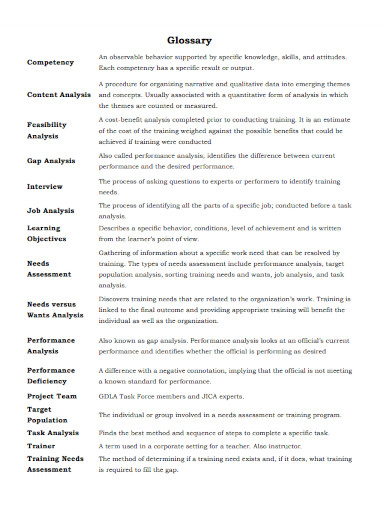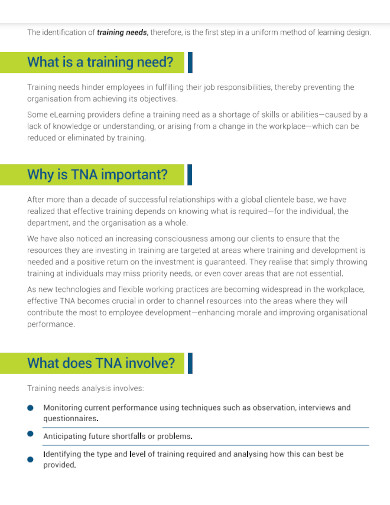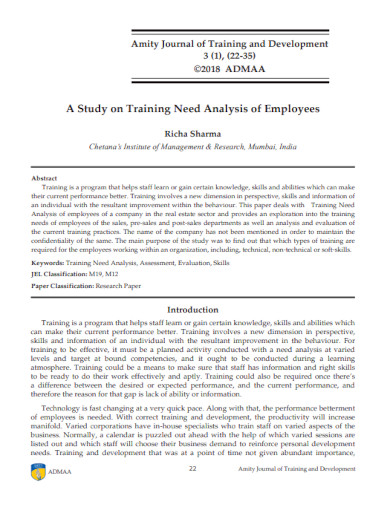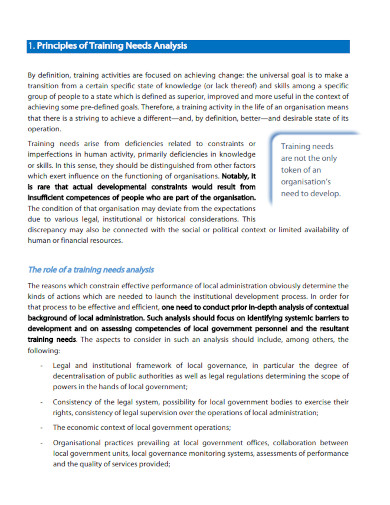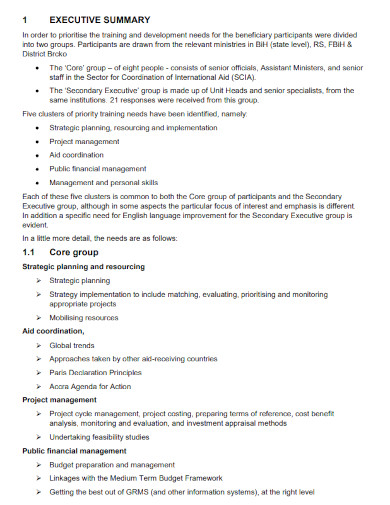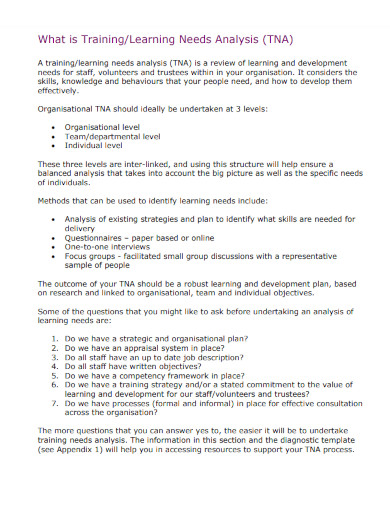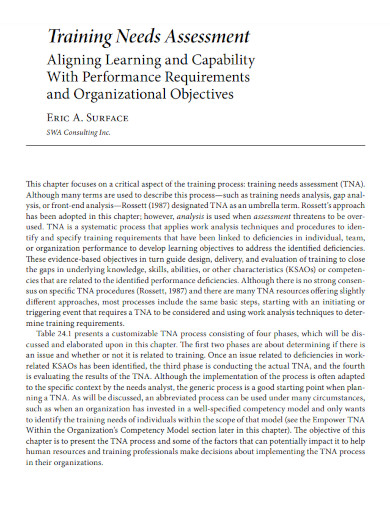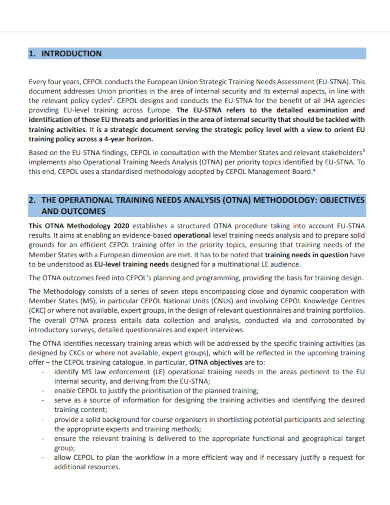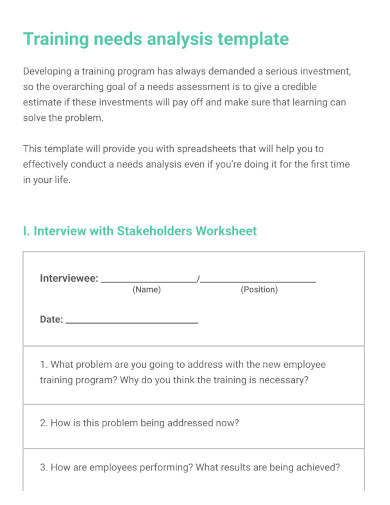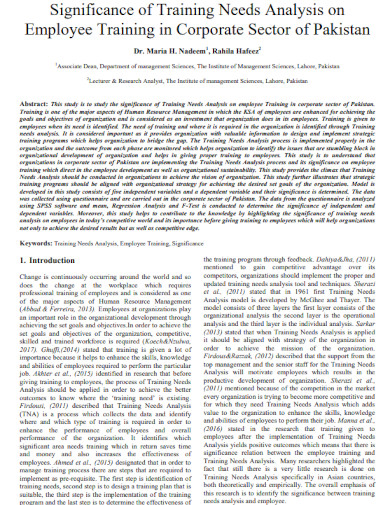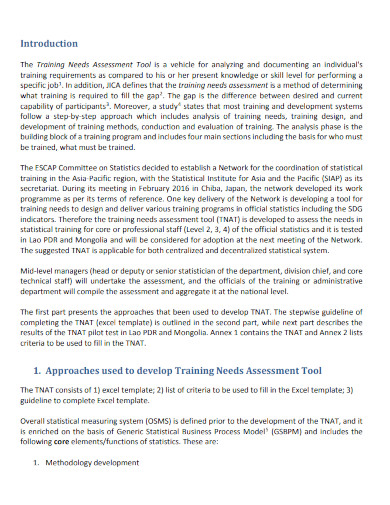The requirements of employees in terms of training and growth plan are always evolving to keep up with the rapid speed of technological advancement. It assists in developing agency staff members for advancement to higher levels. It is helpful to the business manager in identifying critical path development areas of the employees under their supervision. Productivity can grow by a factor of ten or more with appropriate training and development. A variety of businesses have specialists on staff that can educate employees on various facets of the company business. In most cases, an employee’s business requirement to increase personal development needs will be stated on a schedule that is prepared in advance. The employee will select the sessions that best meet their needs from this list.
10+ Training Need Analysis Samples in PDF
1. Training Needs Analysis Assessment
2. Training Needs Analysis Template
3. Training Need Analysis of Employees
4. National Training Needs Analysis
5. Training Needs Analysis Report
6. Training Needs Analysis Example
7. Training Needs Assessment Analysis
8. Operational Training Needs Analysis
9. Sample Training Needs Analysis Template
10. Significance of Training Needs Analysis on Employee
11. Training Needs Assessment Tool Draft
What Is Training Need Analysis?
Training Needs Analysis, or TNA for short, is a method that businesses use to determine what kinds of education and professional development opportunities their workers require to succeed in their jobs. It entails exhaustively studying the training requirements that are necessary at various levels of the organization. In most cases, the outcome is a skills assessment and training requirements analysis for each worker, which can be rolled up into an overall skills gap analysis for the organization. The L&D department should prioritize the process of conducting a training needs assessment since it is of the utmost significance.
How To Make a Training Need Analysis?
It is of the utmost importance to carry out a training needs analysis, which is a procedure that enables L&D leaders to evaluate both present performance and company goals to ascertain which training is required the most. If you skip this essential step, you run the risk of wasting money on programs your learners do not require while neglecting to provide them with the programs they require.
Step 1- Identify the Business Needs
Your employees should leave their training feeling empowered to contribute to achieving your high-level business goals. When you have determined your company’s needs, you will be better able to prioritize the training that will provide the greatest return on investment.
Step 2- Create a View of Roles and Core Competencies
You are aware of the employee groups that will require training to contribute to your organization’s goals. From this vantage point, you can zoom out and go through the work requirements for the team members. This review will provide you with a good benchmark that you may use to assess where your knowledge is lacking in following levels. Nevertheless, searching for job descriptions to discover these prerequisites can be difficult. You might sit down with your Human Resources team or spend hours manually searching job boards to find the right candidate.
Step 3- Shape Training Priorities
Before recommending a solution, it is important to identify any skills and performance gaps first. If training is provided before performance problems are identified, it is analogous to trying to force a square peg into a round hole; the training is unlikely to be applicable or helpful, and the performance gap will continue to widen. We recommend using a combination of these sources to determine where your employees’ skill sets are lacking.
Step 4- Performance Report
Check out the individual performance reports team members submitted for the department you aim to train for. A sales team may report on the number of closed deals for each representative, while a support team might have a graph that displays the average amount of time it takes to resolve a problem for each agent.
What exactly is meant by the term “needs analysis template”?
This template contains room for business information, company goals and requirements, impediments, and essential skill assessments, which can be used to construct a picture of what is required to accomplish goals.
Which tools are used for training need analysis?
These can be online surveys, electronic focus groups, literature searches, and many others.
How can I construct a template for doing a training needs analysis?
Four steps make up the process of conducting a training needs assessment. 1) identify organizational goals 2) describe appropriate job behaviors 3) Specify the appropriate levels of expertise and understanding. 4) training.
Your team’s areas of weakness and opportunities for improvement or retraining can be uncovered with the help of a needs analysis, which is a wonderful tool. The process helps determine where Learning and Development teams should distribute a training budget and finds areas where employees need additional support to retain what they’ve learned to do their jobs effectively.
Related Posts
Sample Material Lists
Sample Excuse Letter for School
Feature Writing Samples
FREE 14+ Sample Music Concert Proposal Templates in MS Word | Google Docs | Pages | PDF
FREE 10+ Security Guard Contract Samples in PDF | MS Word
FREE 10+ Assurance Agreement Samples In MS Word | Google Docs | Apple Pages | PDF
FREE 10+ Option to Purchase Agreement Samples in MS Word | Apple Pages | PDF
FREE 26+ Curriculum Form Samples in MS Word | PDF
FREE 20+ Cleaning Service Proposal Samples in PDF | MS Word
FREE 29+ Sample Loan Application Form Templates in MS Word | PDF
FREE 10+ Event Venue Contract Samples in PDF | MS Word | Pages | Google Docs
FREE 10+ SBAR Samples in PDF | DOC
FREE 12+ Music Band Contract Templates in PDF | MS Word
FREE 10+ HVAC Maintenance Contract Samples in PDF | MS Word
FREE 10+ Social Media Marketing Contract Samples in MS Word | PDF

